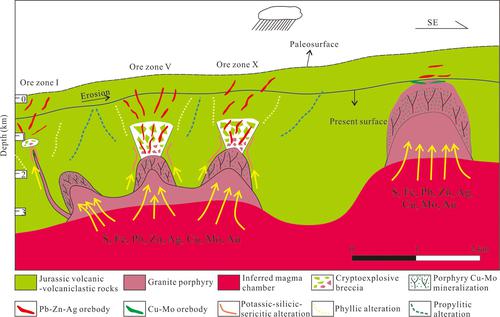当前位置:
X-MOL 学术
›
Acta Geol. Sinica Engl. Ed.
›
论文详情
Our official English website, www.x-mol.net, welcomes your feedback! (Note: you will need to create a separate account there.)
Geochronology, Fluid Inclusions and Isotopic Characteristics of the Dongjun Pb-Zn-Ag Deposit, Inner Mongolia, NE China
Acta Geologica Sinica-English Edition ( IF 3.3 ) Pub Date : 2021-03-30 , DOI: 10.1111/1755-6724.14696 Wei Xie 1 , Shou‐Qin Wen 1 , Guang‐Liang Zhang 1 , Tie‐Qiao Tang 1
Acta Geologica Sinica-English Edition ( IF 3.3 ) Pub Date : 2021-03-30 , DOI: 10.1111/1755-6724.14696 Wei Xie 1 , Shou‐Qin Wen 1 , Guang‐Liang Zhang 1 , Tie‐Qiao Tang 1
Affiliation

|
The Dongjun Pb-Zn-Ag deposit in the northern part of the Great Xing'an Range (NE China) consists of quartz-sulfide vein-type and breccia-type mineralization, related to granite porphyry. Hydrothermal alteration is well-developed and includes potassic-silicic-sericitic alteration, phyllic alteration and propylitic alteration. Three stages of mineralization are recognized on the basis of field evidence and petrographic observation, demarcated by assemblages of quartz-pyrite-arsenopyrite (early stage), quartz-polymetallic sulfide (intermediate stage) and quartz-carbonate-pyrite (late stage). Zircon LA-ICP-MS U-Pb dating indicates that the granite porphyry was emplaced at 146.7 ± 1.2 Ma (Late Jurassic). Microthermometry and laser Raman spectroscopy shows that ore minerals were deposited in conditions of intermediate temperatures (175–359°C), low salinity (0.5–9.3 wt% NaCl eqv.) and low density (0.60–0.91 g/cm3). Ore-forming fluids were derived largely from magmatic hydrothermal processes, with late-stage addition of meteoric water, belonging to a H2O-NaCl-CO2 ± CH4 system. The δ34SV-CDT values range from 0.75‰ to 4.70‰. The 206Pb/204Pb, 207Pb/204Pb, and 208Pb/204Pb values of the ore minerals are in the ranges of 18.240–18.371, 15.542–15.570, and 38.100–38.178, respectively. Data for the S and Pb isotopic systems indicate that the ore-forming metals and sulfur were derived from Mesozoic magma. Based on the geological characteristics and geochemical signatures documented in this study, we conclude that the Dongjun deposit is a mesothermal magmatic hydrothermal vein-type Pb-Zn-Ag deposit controlled by fractures and related to granite porphyry, in response to Late Jurassic tectonic–magmatic–hydrothermal activity. We further conclude that fluid immiscibility, fluid mixing and fluid-rock interactions were the dominant mechanisms for deposition of the ore-forming materials.
更新日期:2021-03-30


























 京公网安备 11010802027423号
京公网安备 11010802027423号